brake fluid Hyundai Genesis Coupe 2016 s Owner's Guide
[x] Cancel search | Manufacturer: HYUNDAI, Model Year: 2016, Model line: Genesis Coupe, Model: Hyundai Genesis Coupe 2016Pages: 475, PDF Size: 15.71 MB
Page 386 of 475

717
Maintenance
135,000 miles (216,000 km) or 108 months
❑Rotate tire
❑ Inspect air cleaner filter
❑ Inspect vacuum hose
❑ Inspect air conditioning refrigerant
❑ Inspect brake hoses and lines
❑ Inspect drive shafts and boots
❑ Inspect exhaust pipe and muffler
❑ Inspect front brake disc/pads, calipers and rotors
❑ Inspect power steering fluid
❑ Inspect power steering pump, belt and hoses
❑ Inspect propeller shaft
❑ Inspect rear brake disc/pads
❑ Inspect steering gear box, linkage & boots/lower arm ball
joint, upper arm ball joint
❑ Inspect suspension mounting bolts
❑ Inspect drive belts *
2
(First, 60,000 miles (96,000 km) or 72 months
after that every 15,000 miles (24,000 km) or 24 months)
❑ Replace climate control air filter (for evaporator and blower unit)
❑ Replace engine oil and filter *
1
❑Add fuel additive *3 (75,000 miles (120,000 km) or 120 months)
127,500 miles (204,000 km) or 102 months
❑ Rotate tire
❑ Inspect air cleaner filter
❑ Inspect power steering fluid
❑ Inspect vacuum hose
❑ Replace engine oil and filter *
1
❑Add fuel additive *3 (97,500 miles (156,000 km) or 156 months)
❈ Inspect : Inspect and if necessary, adjust, correct, clean or
replace.
Page 387 of 475
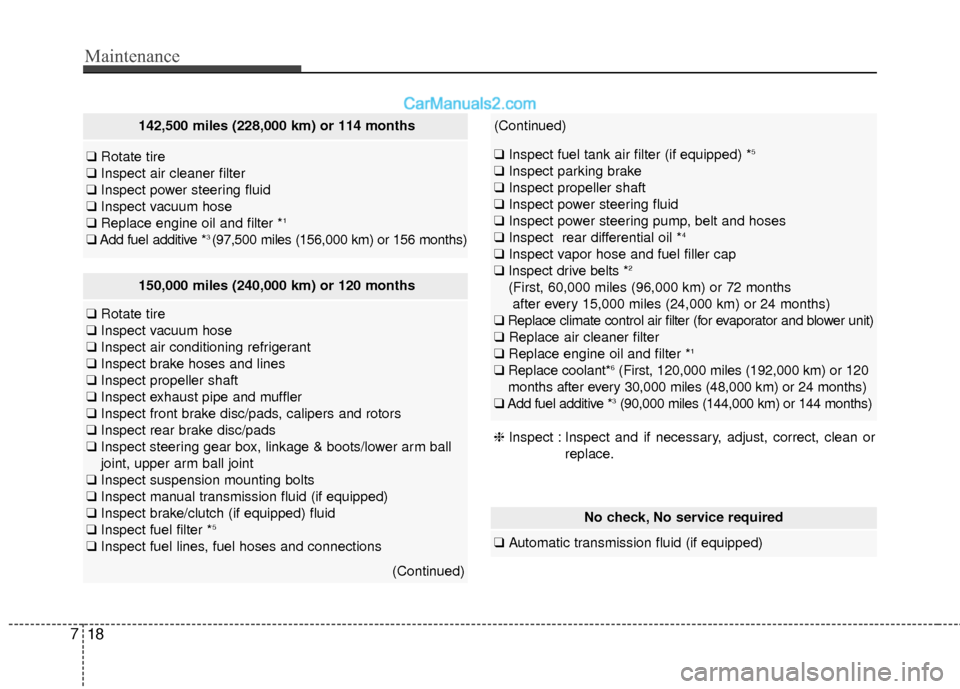
Maintenance
18
7
142,500 miles (228,000 km) or 114 months
❑ Rotate tire
❑ Inspect air cleaner filter
❑ Inspect power steering fluid
❑ Inspect vacuum hose
❑ Replace engine oil and filter *
1
❑Add fuel additive *3 (97,500 miles (156,000 km) or 156 months)
(Continued)
❑ Inspect fuel tank air filter (if equipped) *5
❑Inspect parking brake
❑ Inspect propeller shaft
❑ Inspect power steering fluid
❑ Inspect power steering pump, belt and hoses
❑ Inspect rear differential oil *
4
❑Inspect vapor hose and fuel filler cap
❑ Inspect drive belts *2
(First, 60,000 miles (96,000 km) or 72 months
after every 15,000 miles (24,000 km) or 24 months)
❑ Replace climate control air filter (for evaporator and blower unit)
❑ Replace air cleaner filter
❑ Replace engine oil and filter *
1
❑Replace coolant*6(First, 120,000 miles (192,000 km) or 120
months after every 30,000 miles (48,000 km) or 24 months)
❑ Add fuel additive *
3 (90,000 miles (144,000 km) or 144 months)
150,000 miles (240,000 km) or 120 months
❑ Rotate tire
❑ Inspect vacuum hose
❑ Inspect air conditioning refrigerant
❑ Inspect brake hoses and lines
❑ Inspect propeller shaft
❑ Inspect exhaust pipe and muffler
❑ Inspect front brake disc/pads, calipers and rotors
❑ Inspect rear brake disc/pads
❑ Inspect steering gear box, linkage & boots/lower arm ball
joint, upper arm ball joint
❑ Inspect suspension mounting bolts
❑ Inspect manual transmission fluid (if equipped)
❑ Inspect brake/clutch (if equipped) fluid
❑ Inspect fuel filter *
5
❑Inspect fuel lines, fuel hoses and connections
(Continued)
No check, No service required
❑Automatic transmission fluid (if equipped)
❈ Inspect : Inspect and if necessary, adjust, correct, clean or
replace.
Page 388 of 475
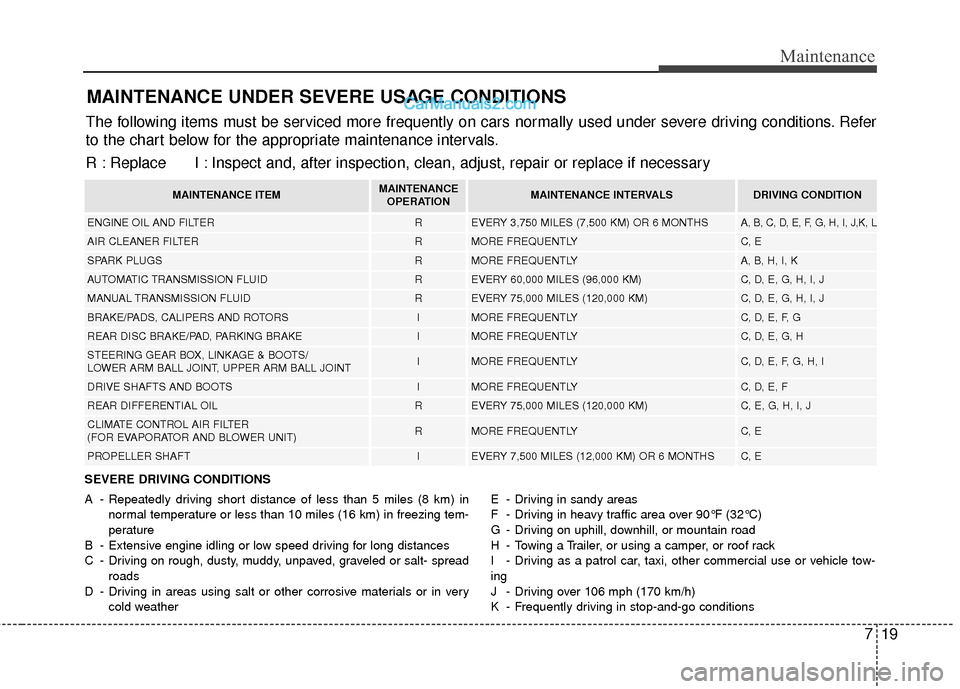
719
Maintenance
MAINTENANCE UNDER SEVERE USAGE CONDITIONS
SEVERE DRIVING CONDITIONS
A - Repeatedly driving short distance of less than 5 miles (8 km) innormal temperature or less than 10 miles (16 km) in freezing tem-
perature
B - Extensive engine idling or low speed driving for long distances
C - Driving on rough, dusty, muddy, unpaved, graveled or salt- spread roads
D - Driving in areas using salt or other corrosive materials or in very cold weather E - Driving in sandy areas
F - Driving in heavy traffic area over 90°F (32°C)
G - Driving on uphill, downhill, or mountain road
H - Towing a Trailer, or using a camper, or roof rack
I - Driving as a patrol car, taxi, other commercial use or vehicle tow-
ing
J - Driving over 106 mph (170 km/h)
K - Frequently driving in stop-and-go conditions
The following items must be serviced more frequently on cars normally used under severe driving conditions. Refer
to the chart below for the appropriate maintenance intervals.
R : Replace I : Inspect and, after inspection, clean, adjust, repair or replace if neces\
sary
MAINTENANCE ITEMMAINTENANCE
OPERATIONMAINTENANCE INTERVALSDRIVING CONDITION
ENGINE OIL AND FILTERREVERY 3,750 MILES (7,500 KM) OR 6 MONTHSA, B, C, D, E, F, G, H, I, J,K, L
AIR CLEANER FILTERRMORE FREQUENTLYC, E
SPARK PLUGSRMORE FREQUENTLYA, B, H, I, K
AUTOMATIC TRANSMISSION FLUIDREVERY 60,000 MILES (96,000 KM)C, D, E, G, H, I, J
MANUAL TRANSMISSION FLUIDREVERY 75,000 MILES (120,000 KM)C, D, E, G, H, I, J
BRAKE/PADS, CALIPERS AND ROTORSIMORE FREQUENTLYC, D, E, F, G
REAR DISC BRAKE/PAD, PARKING BRAKEIMORE FREQUENTLYC, D, E, G, H
STEERING GEAR BOX, LINKAGE & BOOTS/
LOWER ARM BALL JOINT, UPPER ARM BALL JOINTIMORE FREQUENTLYC, D, E, F, G, H, I
DRIVE SHAFTS AND BOOTSIMORE FREQUENTLYC, D, E, F
REAR DIFFERENTIAL OIL REVERY 75,000 MILES (120,000 KM)C, E, G, H, I, J
CLIMATE CONTROL AIR FILTER
(FOR EVAPORATOR AND BLOWER UNIT)RMORE FREQUENTLYC, E
PROPELLER SHAFTIEVERY 7,500 MILES (12,000 KM) OR 6 MONTHSC, E
Page 390 of 475
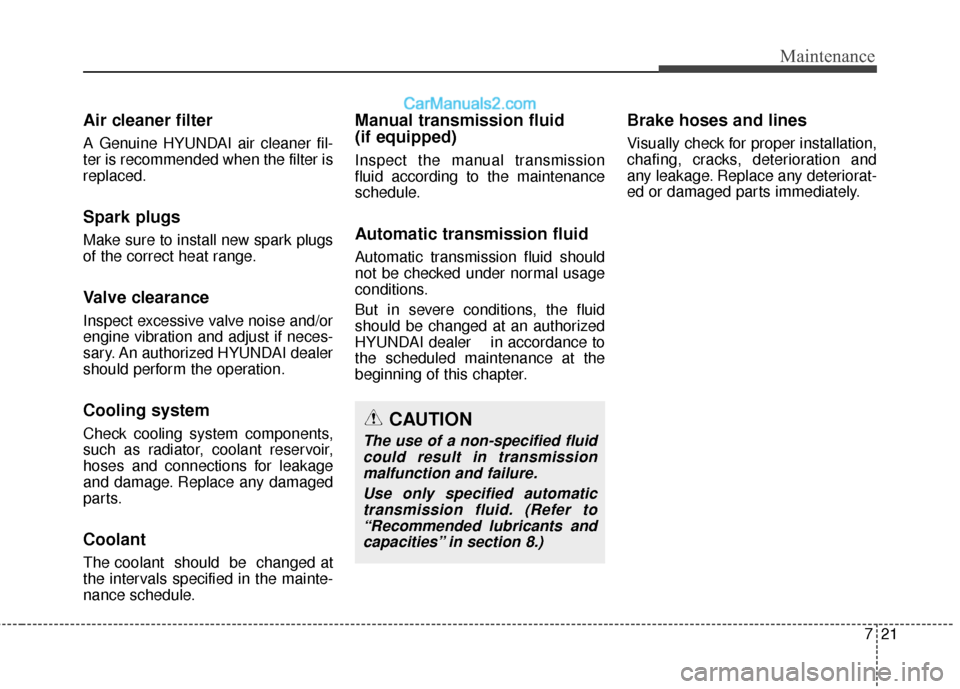
721
Maintenance
Air cleaner filter
A Genuine HYUNDAI air cleaner fil-
ter is recommended when the filter is
replaced.
Spark plugs
Make sure to install new spark plugs
of the correct heat range.
Valve clearance
Inspect excessive valve noise and/or
engine vibration and adjust if neces-
sary. An authorized HYUNDAI dealer
should perform the operation.
Cooling system
Check cooling system components,
such as radiator, coolant reservoir,
hoses and connections for leakage
and damage. Replace any damaged
parts.
Coolant
The coolant should be changed at
the intervals specified in the mainte-
nance schedule.
Manual transmission fluid
(if equipped)
Inspect the manual transmission
fluid according to the maintenance
schedule.
Automatic transmission fluid
Automatic transmission fluid should
not be checked under normal usage
conditions.
But in severe conditions, the fluid
should be changed at an authorized
HYUNDAI dealer in accordance to
the scheduled maintenance at the
beginning of this chapter.
Brake hoses and lines
Visually check for proper installation,
chafing, cracks, deterioration and
any leakage. Replace any deteriorat-
ed or damaged parts immediately.
CAUTION
The use of a non-specified fluidcould result in transmissionmalfunction and failure.
Use only specified automatictransmission fluid. (Refer to“Recommended lubricants andcapacities” in section 8.)
Page 391 of 475
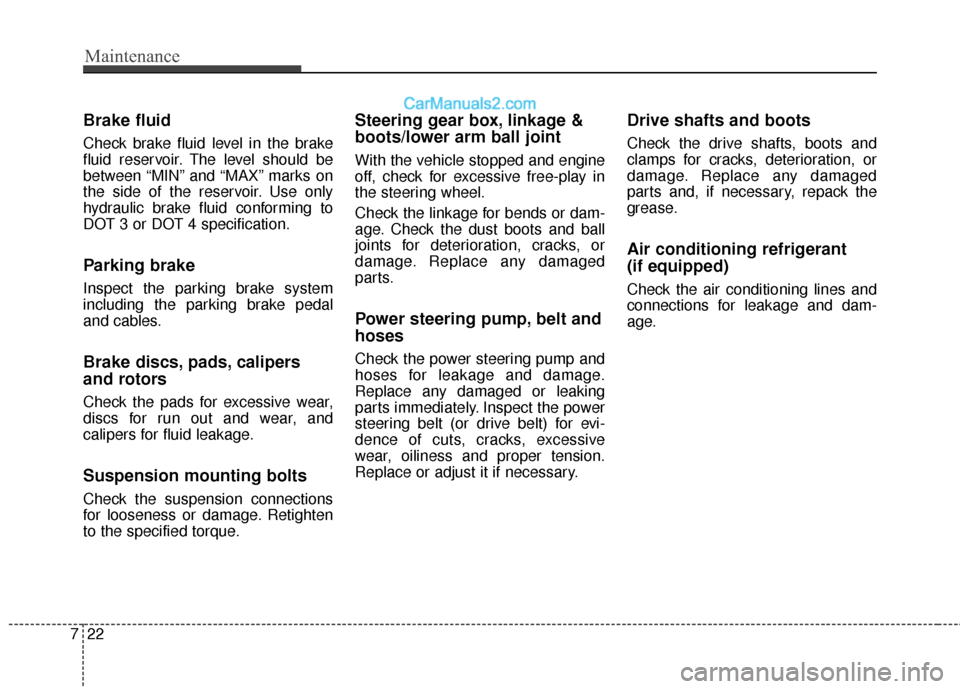
Maintenance
22
7
Brake fluid
Check brake fluid level in the brake
fluid reservoir. The level should be
between “MIN” and “MAX” marks on
the side of the reservoir. Use only
hydraulic brake fluid conforming to
DOT 3 or DOT 4 specification.
Parking brake
Inspect the parking brake system
including the parking brake pedal
and cables.
Brake discs, pads, calipers
and rotors
Check the pads for excessive wear,
discs for run out and wear, and
calipers for fluid leakage.
Suspension mounting bolts
Check the suspension connections
for looseness or damage. Retighten
to the specified torque.
Steering gear box, linkage &
boots/lower arm ball joint
With the vehicle stopped and engine
off, check for excessive free-play in
the steering wheel.
Check the linkage for bends or dam-
age. Check the dust boots and ball
joints for deterioration, cracks, or
damage. Replace any damaged
parts.
Power steering pump, belt and
hoses
Check the power steering pump and
hoses for leakage and damage.
Replace any damaged or leaking
parts immediately. Inspect the power
steering belt (or drive belt) for evi-
dence of cuts, cracks, excessive
wear, oiliness and proper tension.
Replace or adjust it if necessary.
Drive shafts and boots
Check the drive shafts, boots and
clamps for cracks, deterioration, or
damage. Replace any damaged
parts and, if necessary, repack the
grease.
Air conditioning refrigerant
(if equipped)
Check the air conditioning lines and
connections for leakage and dam-
age.
Page 397 of 475
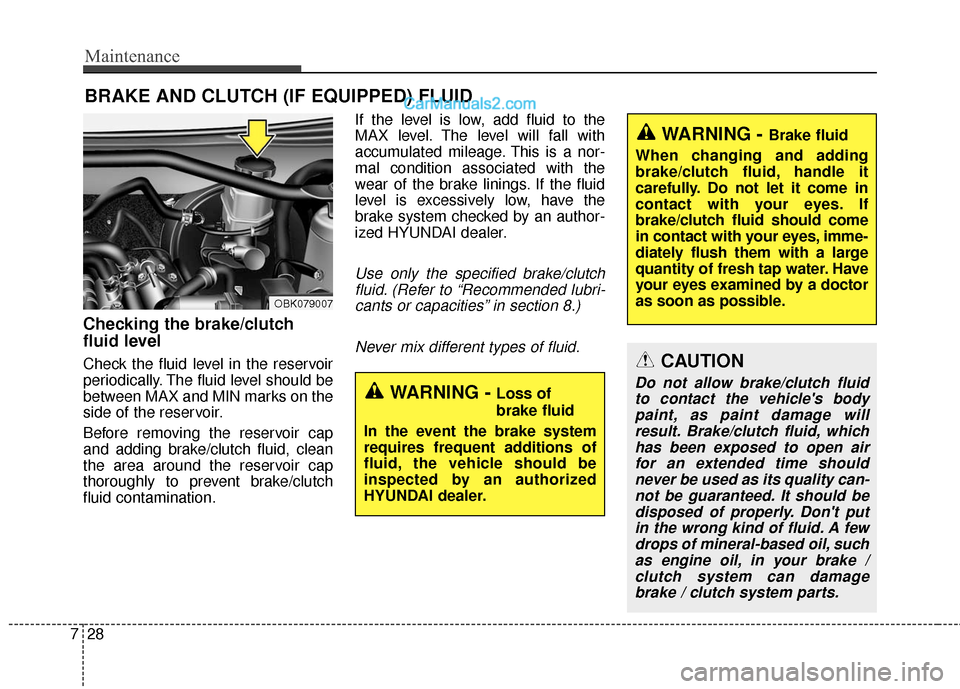
Maintenance
28
7
BRAKE AND CLUTCH (IF EQUIPPED) FLUID
Checking the brake/clutch
fluid level
Check the fluid level in the reservoir
periodically. The fluid level should be
between MAX and MIN marks on the
side of the reservoir.
Before removing the reservoir cap
and adding brake/clutch fluid, clean
the area around the reservoir cap
thoroughly to prevent brake/clutch
fluid contamination. If the level is low, add fluid to the
MAX level. The level will fall with
accumulated mileage. This is a nor-
mal condition associated with the
wear of the brake linings. If the fluid
level is excessively low, have the
brake system checked by an author-
ized HYUNDAI dealer.
Use only the specified brake/clutch
fluid. (Refer to “Recommended lubri-cants or capacities” in section 8.)
Never mix different types of fluid.
WARNING - Brake fluid
When changing and adding
brake/clutch fluid, handle it
carefully. Do not let it come in
contact with your eyes. If
brake/clutch fluid should come
in contact with your eyes, imme-
diately flush them with a large
quantity of fresh tap water. Have
your eyes examined by a doctor
as soon as possible.
WARNING - Loss of
brake fluid
In the event the brake system
requires frequent additions of
fluid, the vehicle should be
inspected by an authorized
HYUNDAI dealer.
OBK079007
CAUTION
Do not allow brake/clutch fluid to contact the vehicle's bodypaint, as paint damage willresult. Brake/clutch fluid, whichhas been exposed to open airfor an extended time shouldnever be used as its quality can-not be guaranteed. It should bedisposed of properly. Don't putin the wrong kind of fluid. A fewdrops of mineral-based oil, suchas engine oil, in your brake /clutch system can damagebrake / clutch system parts.
Page 400 of 475
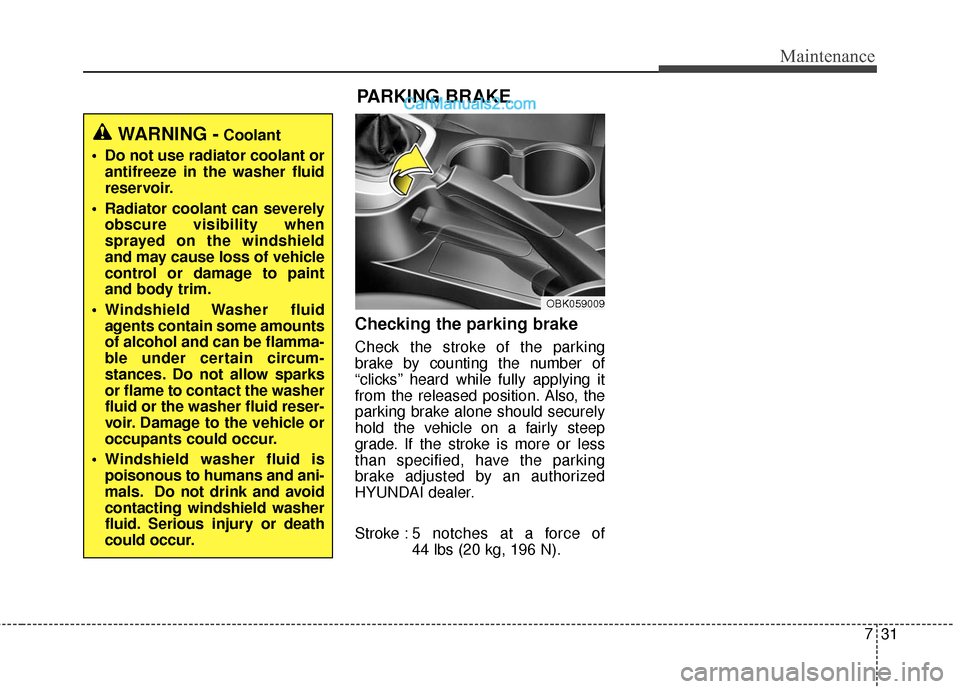
731
Maintenance
Checking the parking brake
Check the stroke of the parking
brake by counting the number of
“clicks’’ heard while fully applying it
from the released position. Also, the
parking brake alone should securely
hold the vehicle on a fairly steep
grade. If the stroke is more or less
than specified, have the parking
brake adjusted by an authorized
HYUNDAI dealer.
Stroke : 5 notches at a force of
44 lbs (20 kg, 196 N).
WARNING -Coolant
Do not use radiator coolant or antifreeze in the washer fluid
reservoir.
Radiator coolant can severely obscure visibility when
sprayed on the windshield
and may cause loss of vehicle
control or damage to paint
and body trim.
Windshield Washer fluid agents contain some amounts
of alcohol and can be flamma-
ble under certain circum-
stances. Do not allow sparks
or flame to contact the washer
fluid or the washer fluid reser-
voir. Damage to the vehicle or
occupants could occur.
Windshield washer fluid is poisonous to humans and ani-
mals. Do not drink and avoid
contacting windshield washer
fluid. Serious injury or death
could occur.
OBK059009
PARKING BRAKE
Page 421 of 475

Maintenance
52
7
Outward Facing Sidewall : The side
of a asymmetrical tire that has a par-
ticular side that faces outward when
mounted on a vehicle. The outward
facing sidewall bears white lettering
or bears manufacturer, brand, and/or
model name molding that is higher or
deeper than the same moldings on
the inner facing sidewall.
Passenger (P-Metric) Tire : A tire
used on passenger cars and some
light duty trucks and multipurpose
vehicles.
Ply: A layer of rubber-coated parallel
cords
Pneumatic tire: A mechanical device
made of rubber, chemicals, fabric and
steel or other materials, that, when
mounted on an automotive wheel
provides the traction and contains the
gas or fluid that sustains the load.
Production options weight : The
combined weight of installed regular
production options weighing over 5
lb.(2.3 kg) in excess of the standard
items which they replace, not previ-
ously considered in curb weight or
accessory weight, including heavy
duty brakes, ride levelers, roof rack,
heavy duty battery, and special trim. Recommended Inflation Pressure
:
Vehicle manufacturer's recommend-
ed tire inflation pressure and shown
on the tire placard.
Radial Ply Tire : A pneumatic tire in
which the ply cords that extend to the
beads are laid at 90 degrees to the
centerline of the tread.
Rim: A metal support for a tire and
upon which the tire beads are seat-
ed.
Sidewall: The portion of a tire
between the tread and the bead.
Speed Rating: An alphanumeric
code assigned to a tire indicating the
maximum speed at which a tire can
operate.
Traction: The friction between the
tire and the road surface. The
amount of grip provided.
Tread: The portion of a tire that
comes into contact with the road.
Treadwear Indicators: Narrow
bands, sometimes called "wear
bars", that show across the tread of a
tire when only 2/32 inch of tread
remains. UTQGS: Uniform Tire Quality
Grading Standards, a tire information
system that provides consumers with
ratings for a tire's traction, tempera-
ture and treadwear. Ratings are
determined by tire manufacturers
using government testing proce-
dures. The ratings are molded into
the sidewall of the tire.
Vehicle Capacity Weight
: The num-
ber of designated seating positions
multiplied by 150 lbs. (68 kg) plus the
rated cargo and luggage load.
Vehicle Maximum Load on the
Tire: Load on an individual tire due to
curb and accessory weight plus
maximum occupant and cargo
weight.
Vehicle Normal Load on the Tire :
Load on an individual tire that is
determined by distributing to each
axle its share of the curb weight,
accessory weight, and normal occu-
pant weight and dividing by 2.
Vehicle Placard: A label permanent-
ly attached to a vehicle showing the
original equipment tire size and rec-
ommended inflation pressure.
Page 459 of 475
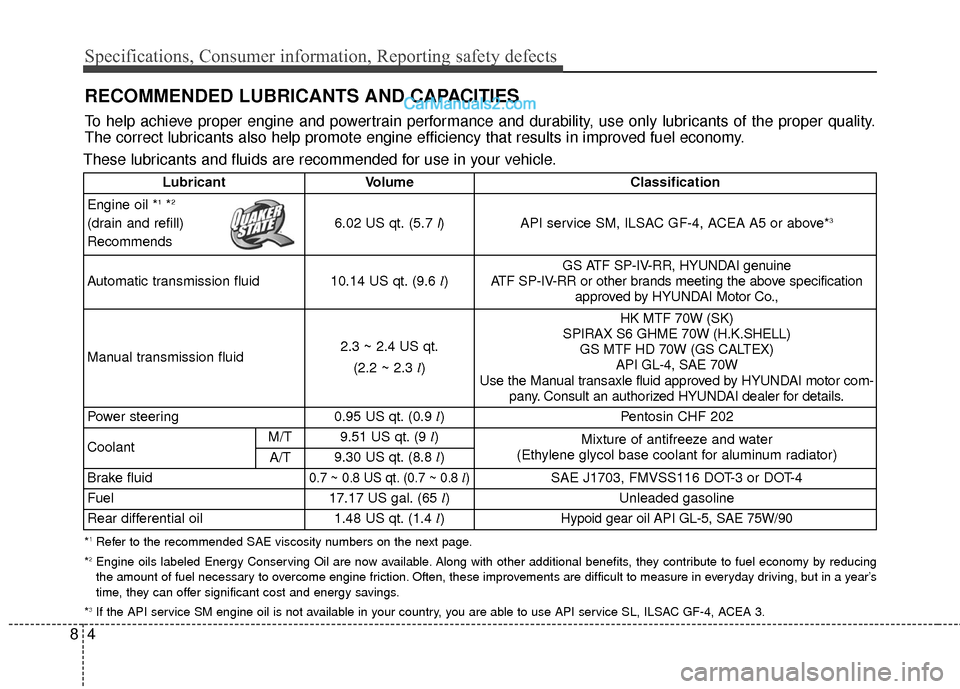
Specifications, Consumer information, Reporting safety defects
48
RECOMMENDED LUBRICANTS AND CAPACITIES
These lubricants and fluids are recommended for use in your vehicle.
*1Refer to the recommended SAE viscosity numbers on the next page.
*2Engine oils labeled Energy Conserving Oil are now available. Along with other additional benefits, they contribute to fuel econo my by reducing
the amount of fuel necessary to overcome engine friction. Often, these improvements are difficult to measure in everyday driving, but in a year’s
time, they can offer significant cost and energy savings.
*
3If the API service SM engine oil is not available in your country, you are able to use API service SL, ILSAC GF-4, ACEA 3.
To help achieve proper engine and powertrain performance and durability, use only lubricants of the proper quality.
The correct lubricants also help promote engine efficiency that results in improved fuel economy.
LubricantVolumeClassification
Engine oil *1*2
(drain and refill)
Recommends6.02 US qt. (5.7 l)API service SM, ILSAC GF-4, ACEA A5 or above*3
Automatic transmission fluid10.14 US qt. (9.6 l)
GS ATF SP-IV-RR, HYUNDAI genuine
ATF SP-IV-RR or other brands meeting the above specification approved by HYUNDAI Motor Co.,
Manual transmission fluid2.3 ~ 2.4 US qt.
(2.2 ~ 2.3 l)
HK MTF 70W (SK)
SPIRAX S6 GHME 70W (H.K.SHELL) GS MTF HD 70W (GS CALTEX) API GL-4, SAE 70W
Use the Manual transaxle fluid approved by HYUNDAI motor com- pany. Consult an authorized HYUNDAI dealer for details.
Power steering0.95 US qt. (0.9 l)Pentosin CHF 202
CoolantM/T9.51 US qt. (9 l) Mixture of antifreeze and water
(Ethylene glycol base coolant for aluminum radiator)
A/T9.30 US qt. (8.8 l)
Brake fluid0.7 ~ 0.8 US qt. (0.7 ~ 0.8 l )SAE J1703, FMVSS116 DOT-3 or DOT-4
Fuel17.17 US gal. (65 l)Unleaded gasoline
Rear differential oil1.48 US qt. (1.4 l)Hypoid gear oil API GL-5, SAE 75W/90
Page 466 of 475
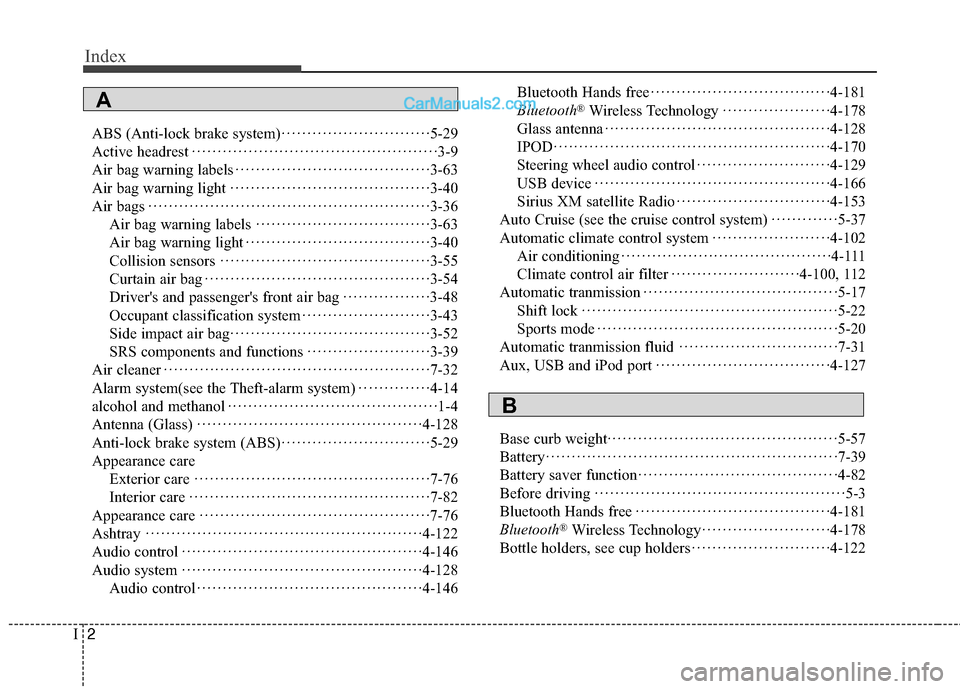
Index
2I
ABS (Anti-lock brake system)··················\
···········5-29
Active headrest ··················\
··················\
············3-9
Air bag warning labels ··················\
··················\
· ·3-63
Air bag warning light ··················\
··················\
·· ·3-40
Air bags ··················\
··················\
··················\
·3-36
Air bag warning labels ··················\
··············· ·3-63
Air bag warning light ··················\
················· ·3-40
Collision sensors ··················\
··················\
···· ·3-55
Curtain air bag ··················\
··················\
······· ·3-54
Driver's and passenger's front air bag ·················3-48
Occupant classification system ··················\
·······3-43
Side impact air bag ··················\
··················\
·· ·3-52
SRS components and functions ··················\
······3-39
Air cleaner ··················\
··················\
··············· ·7-32
Alarm system(see the Theft-alarm system) ··············4-14
alcohol and methanol ··················\
··················\
·····1-4
Antenna (Glass) ··················\
··················\
······· ·4-128
Anti-lock brake system (ABS) ··················\
···········5-29
Appearance care Exterior care ··················\
··················\
········· ·7-76
Interior care ··················\
··················\
·········· ·7-82
Appearance care ··················\
··················\
·········7-76
Ashtray ··················\
··················\
················· ·4-122
Audio control ··················\
··················\
·········· ·4-146
Audio system ··················\
··················\
·········· ·4-128
Audio control ··················\
··················\
······· ·4-146Bluetooth Hands free
··················\
················ ·4-181
Bluetooth
®Wireless Technology ··················\
···4-178
Glass antenna ··················\
··················\
······· ·4-128
IPOD··················\
··················\
················· ·4-170
Steering wheel audio control ··················\
········4-129
USB device ··················\
··················\
········· ·4-166
Sirius XM satellite Radio ··················\
············4-153
Auto Cruise (see the cruise control system) ·············5-37
Automatic climate control system ··················\
·····4-102
Air conditioning ··················\
··················\
·····4-111
Climate control air filter · · · ··················\
····4-100, 112
Automatic tranmission ··················\
··················\
· ·5-17
Shift lock ··················\
··················\
··············5-22
Sports mode ··················\
··················\
·········· ·5-20
Automatic tranmission fluid ··················\
·············7-31
Aux, USB and iPod port ··················\
··············· ·4-127
Base curb weight··················\
··················\
·········5-57
Battery ··················\
··················\
··················\
·· ·7-39
Battery saver function ··················\
··················\
·· ·4-82
Before driving ··················\
··················\
············ ·5-3
Bluetooth Hands free ··················\
··················\
· ·4-181
Bluetooth
®Wireless Technology ··················\
·······4-178
Bottle holders, see cup holders ··················\
·········4-122
A
B